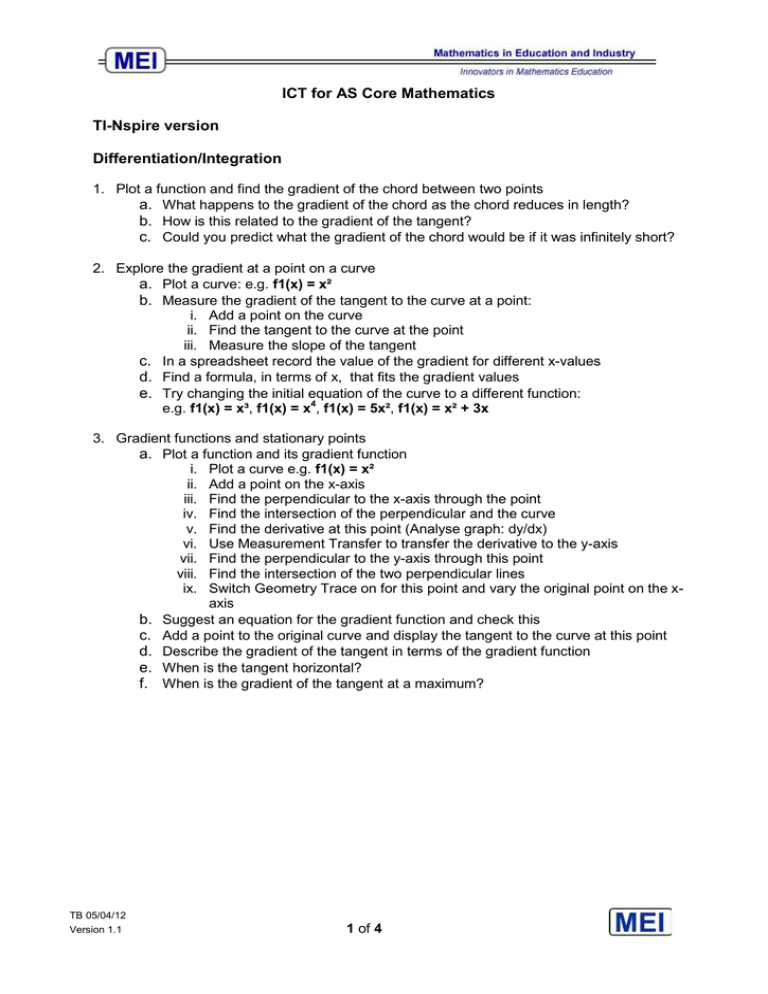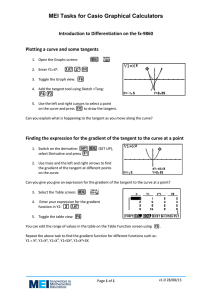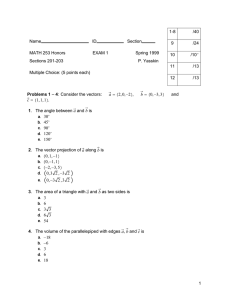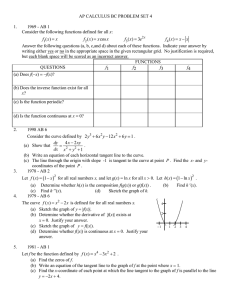a. ICT for AS Core Mathematics TI-Nspire version
advertisement

ICT for AS Core Mathematics TI-Nspire version Differentiation/Integration 1. Plot a function and find the gradient of the chord between two points a. What happens to the gradient of the chord as the chord reduces in length? b. How is this related to the gradient of the tangent? c. Could you predict what the gradient of the chord would be if it was infinitely short? 2. Explore the gradient at a point on a curve a. Plot a curve: e.g. f1(x) = x² b. Measure the gradient of the tangent to the curve at a point: i. Add a point on the curve ii. Find the tangent to the curve at the point iii. Measure the slope of the tangent c. In a spreadsheet record the value of the gradient for different x-values d. Find a formula, in terms of x, that fits the gradient values e. Try changing the initial equation of the curve to a different function: e.g. f1(x) = x³, f1(x) = x4, f1(x) = 5x², f1(x) = x² + 3x 3. Gradient functions and stationary points a. Plot a function and its gradient function i. Plot a curve e.g. f1(x) = x² ii. Add a point on the x-axis iii. Find the perpendicular to the x-axis through the point iv. Find the intersection of the perpendicular and the curve v. Find the derivative at this point (Analyse graph: dy/dx) vi. Use Measurement Transfer to transfer the derivative to the y-axis vii. Find the perpendicular to the y-axis through this point viii. Find the intersection of the two perpendicular lines ix. Switch Geometry Trace on for this point and vary the original point on the xaxis b. Suggest an equation for the gradient function and check this c. Add a point to the original curve and display the tangent to the curve at this point d. Describe the gradient of the tangent in terms of the gradient function e. When is the tangent horizontal? f. When is the gradient of the tangent at a maximum? TB 05/04/12 Version 1.1 1 of 4 4. Tangents and Normals a. Draw the curve f1(x)=x² b. Add two points on the curve c. Display the tangents to the curve at each point d. Find the point of intersection of the two tangents and display its coordinates e. Measure the angle between the two tangents f. Find positions of the two tangents so they are perpendicular. Record the coordinates of the point of intersection of the tangents. g. Repeat f. for different positions of the tangents that are perpendicular. What is the relationship between the points of intersection? h. Can you use this to construct a perpendicular tangent to a given tangent? 5. Stationary points a. Find a cubic with two distinct stationary points and plot it. b. Find the coordinates of the stationary points (using Analyse Graph: maximum or minimum in the region of each of the stationary points and displaying their coordinates) c. Find the coordinates of the point of inflection (using Analyse Graph: Inflection in the region around the centre of the curve and display its coordinates) d. Repeat this for different cubics and observe a relationship between the points i. Prove this relationship using differentiation. 6. Introduction to integration (finding areas under lines) a. Add sliders for m and c b. Draw a line f1(x)=m*x+c (starting with +ve m and c is easiest) c. Find the area under the line up to an x-value: i. Add a point at the origin and the y-intercept using Intersection Point ii. Add a point on the x-axis iii. Find the perpendicular to the x-axis through the point iv. Find the intersection of the perpendicular and the line v. Add a perpendicular to the y-axis through the y-intersection vi. Find the intersection of the two perpendiculars to the axes d. Use the polygon tool to define the triangle and rectangle created e. Find the area of the rectangle and the triangle TB 05/04/12 Version 1.1 2 of 4 f. g. h. i. j. Add the areas to get a total area Can you generalise this? What is the relationship between this and differentiation? Does it work if either m or c are negative? Can you extend this to the area between x = x1 and x = x2? 7. Introduction to integration (finding areas under curves) a. Plot a function and its integral i. Plot a curve e.g. f1(x) = x² ii. Add a point at the origin iii. Add a point on the x-axis iv. Find the perpendicular to the x-axis through the point v. Find the intersection of the perpendicular and the curve vi. Find the integral of the curve between the origin and this point (Analyse graph: Integral) vii. Use Measurement Transfer to transfer the Integral to the y-axis viii. Find the perpendicular to the y-axis through this point ix. Find the intersection of the two perpendicular lines x. Switch Geometry Trace on for this point and vary the original point on the xaxis b. What function would pass through these points? c. How is the Area function related to the original function? 8. Integration (reverse of differentiation) a. Add sliders a and b b. Plot f1(x)=a*x+b c. Find a function f2(x) that would have f1(x) as its gradient function: i. Plot a curve e.g. f2(x)=x² ii. Add a point on the x-axis iii. Find the perpendicular to the x-axis through the point iv. Find the intersection of the perpendicular and the curve v. Find the derivative at this point (Analyse graph: dy/dx) vi. Use Measurement Transfer to transfer the derivative to the y-axis vii. Find the perpendicular to the y-axis through this point viii. Find the intersection of the two perpendicular lines ix. If f1(x) is the gradient function for f2(x) then the point should move along f1(x) d. Repeat c. for different values of a and b e. Add a third slider c f. Change the function f1(x) to f1(x) =a*x²+b*x+c g. Find a function f2(x) that would have f1(x) as its gradient function. TB 05/04/12 Version 1.1 3 of 4 9. Finding general cases of cubics a. Add sliders named a, b c and d b. Plot f1(x)=a*x³+b*x²+c*x+d c. Find values of a, b c and d so that the curve has: i. 2 stationary points ii. 1 stationary point iii. 0 stationary points d. What are the conditions on a cubic that determine whether it has 0, 1, 2 stationary points? 10. Trapezium rule a. Open a new Graphs page and plot a function that you can’t integrate e.g. f1(x)=sinx, f1(x)=x*cosx, f1(x)=2x, f1(x)=√(1-x^(2)) b. Open a Lists and Spreadsheet page and use this to estimate the area under the curve between 0 and 1 by the trapezium rule with a strip size of 0.2: i. In cells A1:A6 enter 0, 0.2, 0.4, 0.6, 0.8, 1 ii. In cell B1 enter =f1(A1) and fill down to B6 iii. In cells C1 and C6 enter 1, in cells C2:C6 enter 2 iv. In cell D1 enter =B1*C1 and fill down to D6 v. In cell D7 enter =sum(D1:D6) vi. In cell D8 enter 0.2 (the strip size) vii. In cell D9 enter =.5*D8*D7 c. Compare the value of the area to integral on the Graphs page: Analyse graph: Integral from 0 to 1. What is the percentage error in the trapezium rule estimate? d. How could you find an improved trapezium rule estimate? TB 05/04/12 Version 1.1 4 of 4







